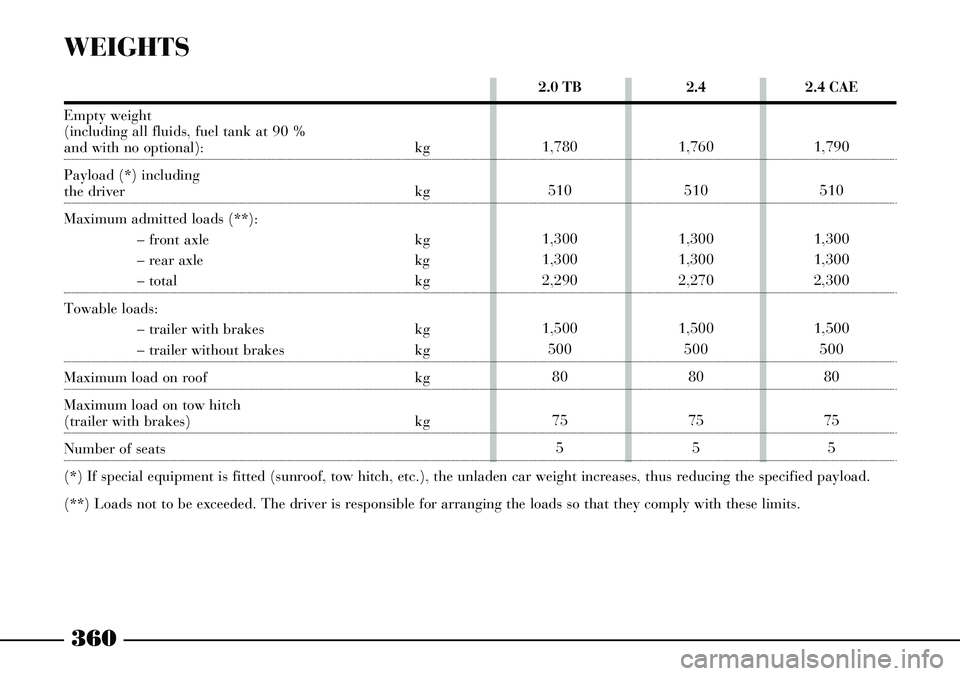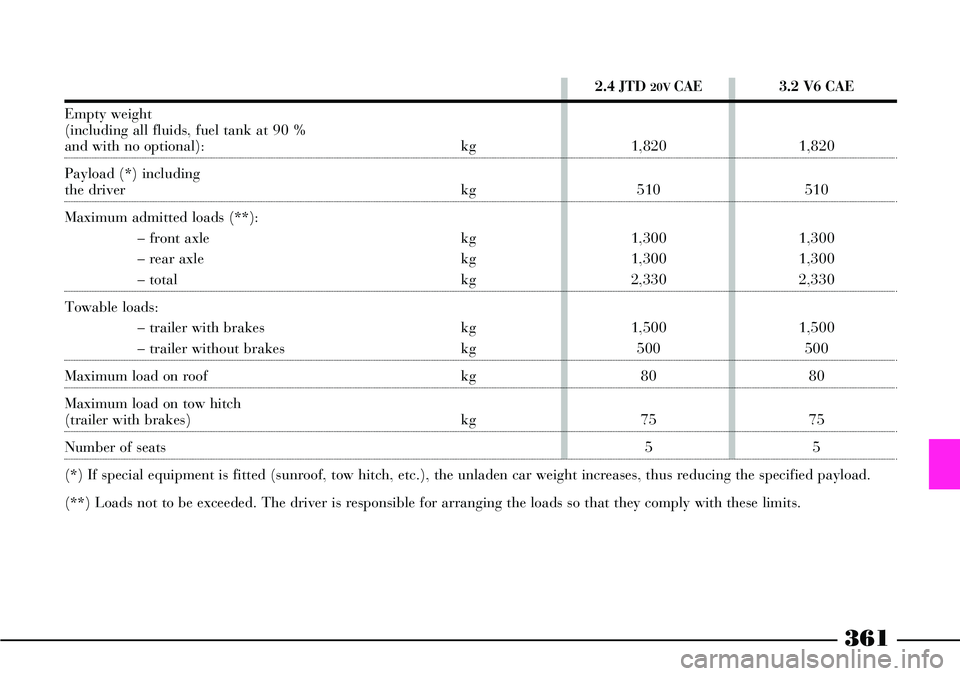ESP Lancia Thesis 2006 Owner handbook (in English)
[x] Cancel search | Manufacturer: LANCIA, Model Year: 2006, Model line: Thesis, Model: Lancia Thesis 2006Pages: 386, PDF Size: 8.69 MB
Page 321 of 386

320
IMPORTANTAfter topping up, let
the engine turn for a few seconds
and wait a few minutes after stop-
ping it before you check the level.
Engine oil consumption
Max. engine oil consumption is
usually 400 grams every 1000 km.
When the car is new, the engine
needs to run in, therefore the engine
oil consumption can only be consid-
ered stabilised after the first 5000 -
6000 km. ENGINE OIL
(fig. 7-8-9-10-11-12)
Check engine oil with the car on
level ground and while the engine is
still warm (approximately five min-
utes after stopping the engine).
Remove dipstick Aand clean it,
than plunge it down and check
whether the oil level is included
between the MINand MAXrefer-
ence lines on the dipstick. The gap
between the MINand MAXrefer-
ence lines corresponds to approxi-
mately one litre of oil.Do not add oil with dif-
ferent specifications (class,
viscosity, etc.) from the oil
already in the engine.
If the oil level is near or even below
the MINline, pour in oil through the
filler hole B, until it reaches the
MAXline.
IMPORTANTIf during a routine
check you will find that the oil level
is above the MAXreference line,
contact a Lancia Dealershipto
have the proper level restored. Be very careful under the
bonnet: you risk burning
yourself. Rememberthat
when the engine is hot, the fan
can start up and cause injuries.
fig. 7 - 2.0 TB version
L0A0323b
fig. 8 - 2.4 - 2.4 CAE versions
L0A0291b
Page 330 of 386

329
USEFUL ADVICE FOR
LENGTHENING THE LIFE OF
YOUR BATTERY
To prevent rapidly draining the
battery and ensure that it continues
to work correctly, the following
should be noted:
– Terminals must always be firmly
tightened.
– Do not keep accessories (e.g.
sound system, hazard lights, parking
lights, etc.).
– When you park the car, ensure
the doors, boot and bonnet are
closed properly. The ceiling lights
must be off.
– Before working on the electrical
system, disconnect the negative
cable from the battery.– If after buying the car, you want
to install electric accessories which
require permanent electric supply,
visit a Lancia Dealership, whose
qualified personnel, in addition to
suggesting the most suitable devices
belonging to the Lineaccessori
Lancia, will evaluate the overall
electric absorption, checking
whether the car’s electric system is
capable of withstanding the load
required, or whether it should be
integrated with a more powerful
battery. These devices in fact take
electricity also when the ignition key
is removed (car parked, engine off),
and can gradually drain the battery.
The overall intake of these devices
(standard and after-market) must
be less than 0.6 mA x Ah (of the bat-
tery), as shown in the following
table.Battery Maximum
idle intake
70 Ah 42 mA
80 Ah 48 mA
100 Ah 60 mA
It is also important to remember
that high intake devices (such as
bottle warmers, vacuum cleaners,
cellular phones, frigo bar, etc.) will
speed up battery discharging when
powered with engine off or running
idle.
– Please note that when installing
additional systems in the car, incor-
rect wiring can be dangerous espe-
cially when concerning safety sys-
tems.
Page 336 of 386

335
HEADLIGHT
WASHERS
Regularly check that the nozzles
(fig. 22) are intact and clean.
The headlight washers are auto-
matically switched on when the
windscreen washer is operated and
the headlights are on.
CLIMATE
CONTROL SYSTEM
During the winter, the climate con-
trol system must be turned on at
least once a month for about ten
minutes.
Before summer, have the system
checked at a Lancia Dealership.INITIALISING THE AIR
CONDITIONING CONTROL UNIT
Whenever the battery is electrically
connected again or it is reloaded after
being completely flat or after replac-
ing one of the protection fuses, to re-
store the correct operation of the air
conditioning, of the door locking and
of the ESP system. It is necessary to
perform the initialisation operations
contained in the paragraph “If battery
is to be disconnected” in the chapter
“In an emergency”.
fig. 22
L0A0122b
The system is filled with
R134a refrigerant which
will not pollute the envi-
ronment in the event of leakage.
Under no circumstances should
R12 fluid be used as it is incom-
patible with the system compo-
nents and contains CFC.
Page 343 of 386

342
BODYWORK PAINT
IDENTIFICATION PLATE
The plate (fig. 4) is applied on the
inner bonnet panel.
fig. 4
L0A0299b
fig. 5
L0A0268b
F- Maximum vehicle weight fully
loaded with trailer
G- Maximum vehicle weight on
front axle
H- Maximum vehicle weight on
rear axle
I- Engine type
L- Body version code
M- Spare part code
N- Smoke opacity index (for diesel
engines)
fig. 3
L0A0298b
It bears the following data (fig. 5):
A- Paint manufacturer
B- Colour name
C- LANCIA colour code
D- Respray and touch up code
Page 345 of 386

344
2.0 TB
841E000
Front,
transversally-mounted
Otto
5 in line
4 - Hydraulic
tappets
82 x 75.65
1,998
8.5 : 1
136
185
5,500
308
31.4
2,200
Unleaded
petrol 95 R.O.N. 2.4
841D000
Front,
transversally-mounted
Otto
5 in line
4 - Hydraulic
tappets
83 x 90.4
2,446
10.3 : 1
125
170
6,000
226
23.0
3,500
Unleaded
petrol 95 R.O.N. 2.4 CAE
841D000
Front,
transversally-mounted
Otto
5 in line
4 - Hydraulic
tappets
83 x 90.4
2,446
10.3 : 1
125
170
6,000
226
23.0
3,500
Unleaded
petrol 95 R.O.N.
ENGINE
GENERAL FEATURES
Engine code
Location
Cycle
Number and layout of cylinders
Number of valves per
cylinder
Diameter x stroke mm
Total capacity cc
Compression ratio
Maximum power (EEC): kW
HP
corresponding ratio rpm
Maximum torque (EEC): Nm
Kgm
corresponding ratio rpm
Fuel
Page 346 of 386

345
3.2 V6 CAE
841L000
Front,
transversally-mounted
Otto
6 V, 60°
4 - Hydraulic
tappets
93 x 78
3,179
10 : 1
169
230
6,200
289
29
4,800
Unleaded
petrol 95 R.O.N. 2.4 JTD 20V CAE
841H000
Front,
transversally-mounted
Diesel
5 in line
4 - Hydraulic
tappets
82 x 90.4
2,387
17 : 1
136
185
4,000
330
34
1,750
Diesel fuel for
motor vehicles
GENERAL FEATURES
Engine code
Location
Cycle
Number and layout of cylinders
Number of valves per
cylinder
Diameter x stroke mm
Total capacity cc
Compression ratio
Maximum power (EEC): kW
HP
corresponding ratio rpm
Maximum torque (EEC): Nm
Kgm
corresponding ratio rpm
Fuel
Page 358 of 386

357
Maximum speed index
Q= up to 160 km/h
R= up to 170 km/h
S= up to 180 km/h
T= up to 190 km/h
U= up to 200 km/h
H= up to 210 km/h
V= over 210 km/h
ZR= over 240 km/h
W= up to 270 km/h
Y= up to 300 km/h
Maximum speed index
for snow tyres
QM + S= up to 160 km/h
TM + S= up to 190 km/h
HM + S= up to 210 km/h Load index (capacity)
60 = 250 kg
61 = 257 kg
62 = 265 kg
63 = 272 kg
64 = 280 kg
65 = 290 kg
66 = 300 kg
67 = 307 kg
68 = 315 kg
69 = 325 kg
70 = 335 kg
71 = 345 kg
72 = 355 kg
73 = 365 kg
74 = 375 kg
75 = 387 kg
76 = 400 kg
77 = 412 kg
78 = 425 kg
79 = 437 kg
80 = 450 kg
81 = 462 kg
82 = 475 kg
83 = 487 kg84 = 500 kg
85 = 515 kg
86 = 530 kg
87 = 545 kg
88 = 560 kg
89 = 580 kg
90 = 600 kg
91 = 615 kg
92 = 630 kg
93 = 650 kg
94 = 670 kg
95 = 690 kg
96 = 710 kg
97 = 730 kg
98 = 750 kg
99 = 775 kg
100 = 800 kg
101 = 825 kg
102 = 850 kg
103 = 875 kg
104 = 900 kg
105 = 925 kg
106 = 950 kg CORRECT RIM
READING
Below, please find the instructions
needed to understand the meaning
of the code stamped on the rim, as
shown in fig. 6.
Example: 7 J x 16 H2 39
7= rim width in inches (1)
J= rim drop centre outline (side
projection where the tyre
bead rests) (2)
16= rim nominal diameter in
inches (corresponds to diam-
eter of the tyre to be mount-
ed) (3=Ø)
H2= hump shape and number
(relief on the circumference
holding the tubeless tyre
bead on the rim)
39= wheel camber (distance
between rim point of contact
and wheel rim centre line)
Page 361 of 386

360
2.4
1,760
510
1,300
1,300
2,270
1,500
500
80
75
52.4 CAE
1,790
510
1,300
1,300
2,300
1,500
500
80
75
5 2.0 TB
1,780
510
1,300
1,300
2,290
1,500
500
80
75
5
WEIGHTS
Empty weight
(including all fluids, fuel tank at 90 %
and with no optional): kg
Payload (*) including
the driver kg
Maximum admitted loads (**):
– front axle kg
– rear axle kg
– total kg
Towable loads:
– trailer with brakes kg
– trailer without brakes kg
Maximum load on roof kg
Maximum load on tow hitch
(trailer with brakes) kg
Number of seats
(*) If special equipment is fitted (sunroof, tow hitch, etc.), the unladen car weight increases, thus reducing the specified payload.
(**) Loads not to be exceeded. The driver is responsible for arranging the loads so that they comply with these limits.
Page 362 of 386

361
2.4 JTD 20V CAE
1,820
510
1,300
1,300
2,330
1,500
500
80
75
53.2 V6 CAE
1,820
510
1,300
1,300
2,330
1,500
500
80
75
5
Empty weight
(including all fluids, fuel tank at 90 %
and with no optional): kg
Payload (*) including
the driver kg
Maximum admitted loads (**):
– front axle kg
– rear axle kg
– total kg
Towable loads:
– trailer with brakes kg
– trailer without brakes kg
Maximum load on roof kg
Maximum load on tow hitch
(trailer with brakes) kg
Number of seats
(*) If special equipment is fitted (sunroof, tow hitch, etc.), the unladen car weight increases, thus reducing the specified payload.
(**) Loads not to be exceeded. The driver is responsible for arranging the loads so that they comply with these limits.
Page 367 of 386

366
FUEL
CONSUMPTION
The fuel consumption values
shown in the following table were
defined according to the type-
approval specifications in European
Directives.
Consumption values are defined by
means of the following procedures:– urban cycle: consisting of a cold
start and a simulated drive in city
streets;
– extra-urban cycle: consisting in
frequent accelerations, in all gears,
simulating normal conditions of use.
Speed ranges from 0 to 120 km/h;
– combined consumption: con-
sisting of 37% urban cycle and 63%
extra-urban cycle.IMPORTANTRoad and traffic
conditions, weather, general condi-
tions of the car, driving style, fittings
and accessories, use of the climate
control system, load, roof racks and
other situations penalising aerody-
namic penetration and effecting
rolling resistance will influence fuel
consumption rates which can be dif-
ferent from the values shown in the
table (see “Cheap running that
respects the environment” in
“Driving your car” chapter).
2.4
15.2
8.4
10.9 2.0 TB
15.5
8.5
11.12.4 CAE
17.4
8.8
12.02.4 JTD 20V CAE
12.1
6.9
8.83.2 V6 CAE
22.7
10.3
14.9Consumption according
to Directive
1999/100/CE(litres x 100 km)
Urban
Extra-urban
Average combined